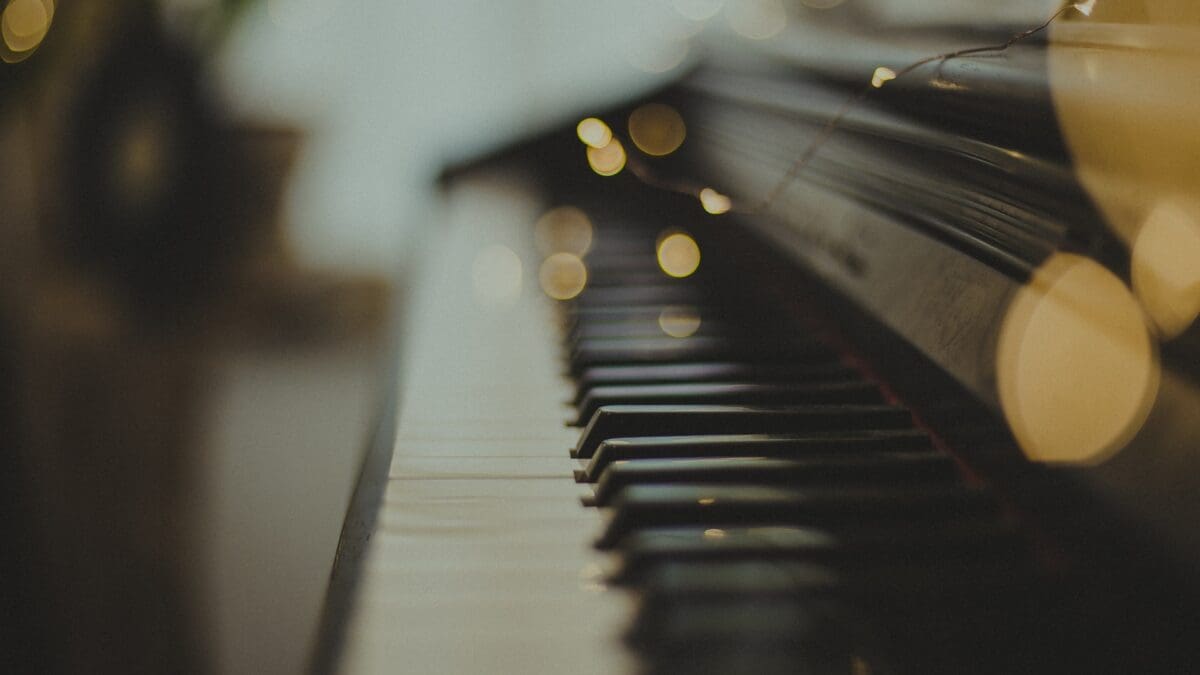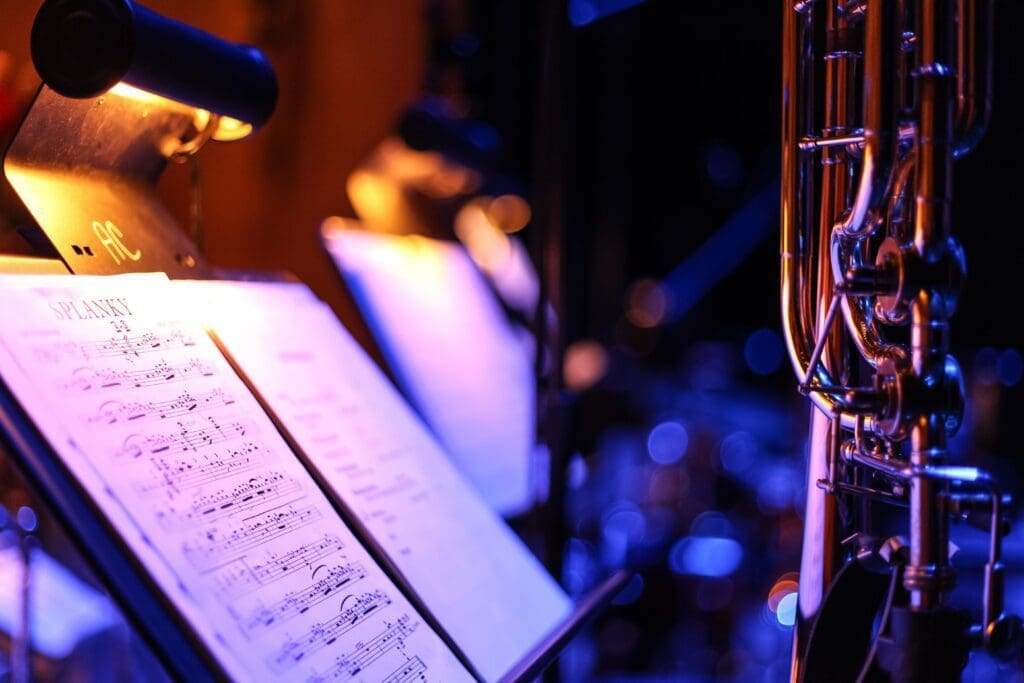
You’ve probably seen plenty of sheet music symbols, such as different notes and clefs, but what actually is it? With a history nearly as old as the written word, written music has been an essential tool in developing music composition throughout the years. In this article, we’ll tell you everything you need to know about sheet music, including its history, how to read it, and how you can get free sheet music.
What Is Sheet Music?
It is a type of handwritten or printed music notation, a visual representation of all of the audible musical or vocal elements in a composition. A well-notated piece of sheet music will cover everything a musician needs to know to recite a composition, including the notes they need to play and when and how to play them.
While a musician will receive sheet music containing all the information they need to play their parts, the conductor will have access to a score for complicated orchestral pieces. This includes all of the musical elements in a composition.
Depending on the complexity and length of the piece, sheet music can range from as little as a few lines or as much as a whole book. Historically, sheet music would be transcribed on paper or, in more ancient iterations, on papyrus or even stone tablets. However, with modern advances, digital sheet music has become a convenient and efficient means of sharing and reading compositions.
History of Sheet Music
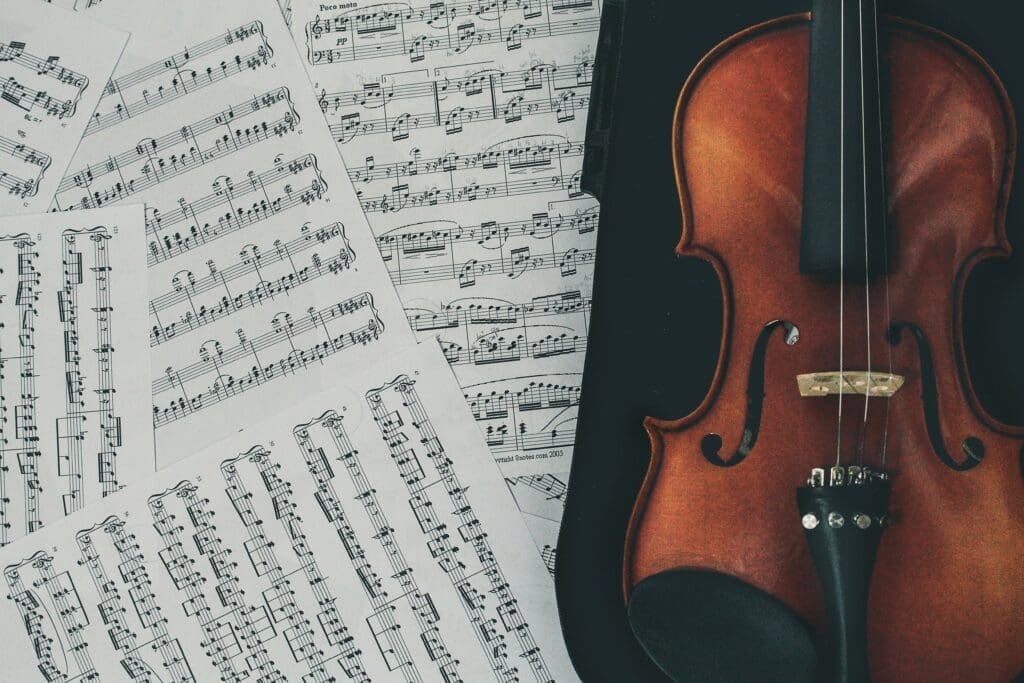
Transcribing music in its modern form, known as Western musical notation, dates back to the 15th century. However, there is evidence of ancient musical notations recorded in tablets by the ancient Sumerians over 4,000 years ago.
With the advent of the moveable-type printing press in the 15th century, it became easier to duplicate and distribute sheet music. But, as compositions became more elaborate, so too did printing requirements, leading to necessary further developments in music engraving and printing.
In the 19th century, the publishing industry blossomed, making it easier to source sheet music than ever before. However, the 20th century saw the introduction of the phonograph and the rise of radio broadcasting. These inventions meant that music was more accessible to the public, and sheet music sales quickly plummeted as a result.
In the modern era, digital sheet music has revolutionised music notation. Specialist software allows composers to quickly notate their compositions, while some digital audio workstations also include the ability to generate it from MIDI recordings automatically.
Why Is Sheet Music Important?
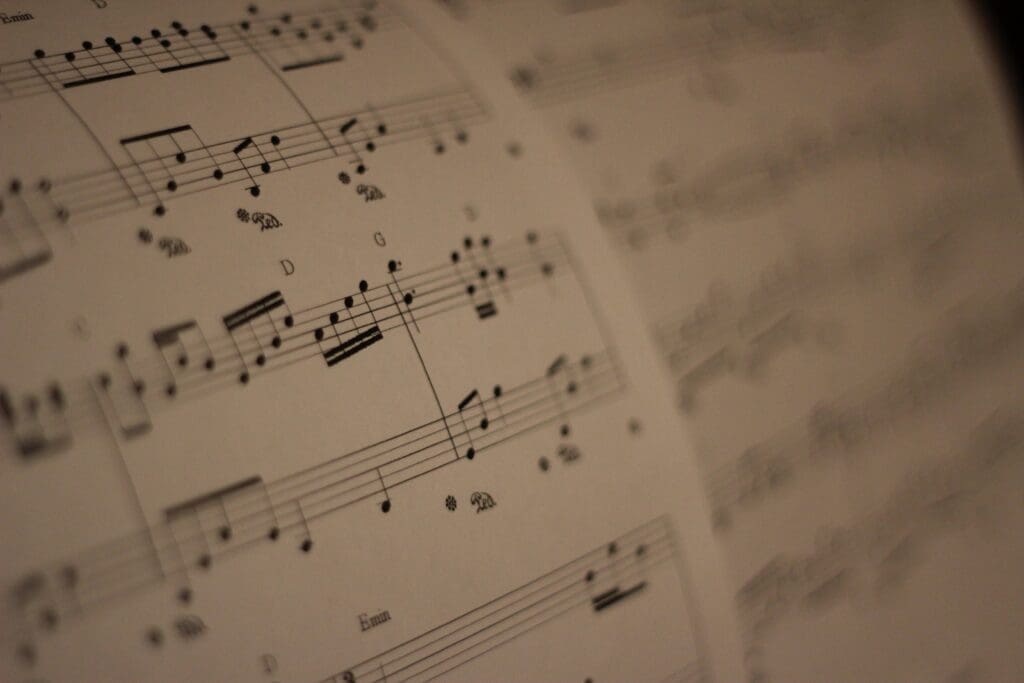
For a musician, sheet music fits perfectly with learning music theory. While you don’t need to be able to read it, it will undoubtedly assist you in developing a better understanding of music theory, helping you to become a better musician along the way.
It also helps musicians to collaborate more easily. With properly prepared sheet music, you can quickly share ideas, avoid confusion, and learn the material together. As they include indicators of tempo and rhythm, you’ll also be able to stay in time better.
For composers and conductors, sheet music is essential. While audio recording means that it is no longer the only method of communicating music, It is still perhaps the most efficient means of explaining the elements of a composition. And for composers, sheet music makes it possible for them to communicate with musicians and guide an entire orchestra through a composition.
How To Read Sheet Music
When you see sheet music for the first time, it’s easy to feel overwhelmed by the amount of information and perhaps a few unfamiliar symbols. However, once you get to know the basics, reading it becomes a logical and organised process that you will only get better at the more you practise. But before you jump straight in and try to decipher a music score, take time to read through our helpful guide and learn more about the essential elements of written music.
Staff

The entire construction of written music revolves around the staff, which acts as an information highway for the various symbols and notes that describe a composition. A staff, also known as a stave, visually appears as five lines and four spaces, with each line and space representing a different musical note.
For instruments with particularly large ranges, such as pianos and harps, it will typically also use a grand staff, which is essentially two staffs joined together with a gap between them.
Clefs
A clef is one of the first symbols you’ll see on a music sheet, appearing at the start of a staff. Clefs indicate which musical notes are represented by the staff’s lines and spaces. Several types of clefs can appear but the most common ones are treble and bass.
Where sheet music uses grand staffs, the top staff will feature a treble clef while the bottom has a bass clef.
Ledger Lines
No matter what clef is used, there are often occasions where a composition will have more notes than can be represented in a standard staff. In such situations, you can employ ledger lines. Ledger lines are a way of indicating pitches that fall outside the range of the staff. They appear as a small line either above or below the staff. These lines are very short, only appearing where necessary for individual notes.
Key Signature
At the beginning of a section of music, you might find some # or b symbols on the staff. These are called key signatures, and they indicate whether you need to play any notes in a scale sharp or flat. Generally, an initial key signature can appear immediately after the clef, indicating the composition’s overall key. However, should a later section feature a different key, additional key signatures will appear before that section of music.
Time Signature
Following the key signature at the beginning of the sheet music, you’ll also see the time signature, which appears as two numbers, one above the other. The top number represents the number of beats played per bar, while the bottom number indicates what type of note to play, such as a half note (2), quarter note (4), or eighth note (8).
The most common time signature is 4/4, meaning that the measure contains four quarter notes.
Measures/Bars
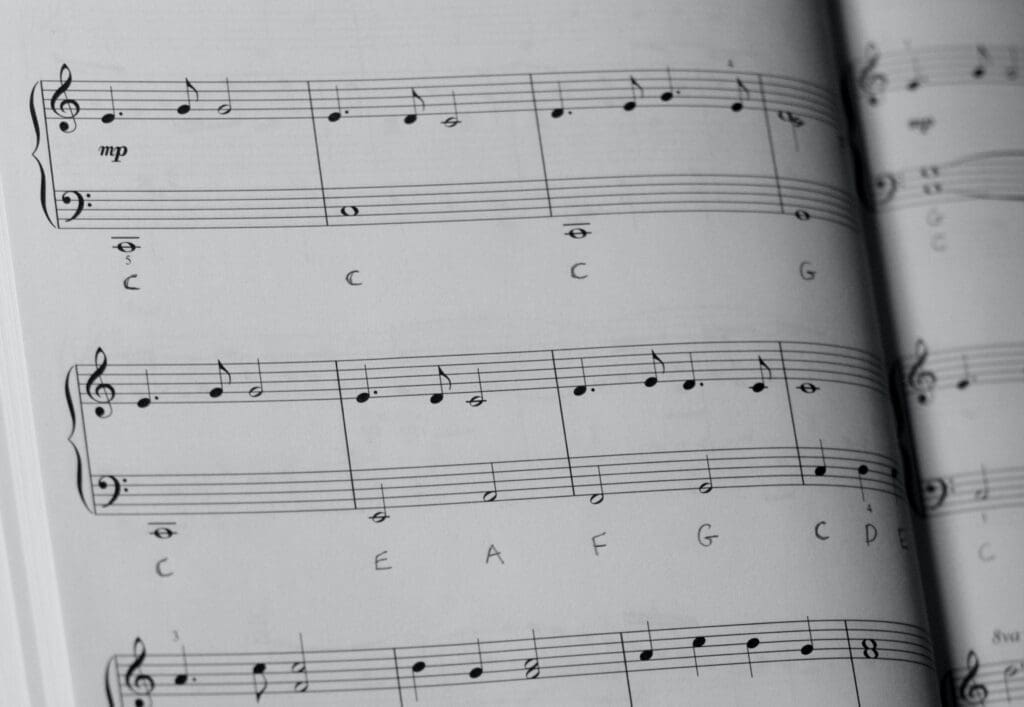
Musical compositions are broken down into smaller, more manageable sections called measures (or bars). Measures are identified by a vertical line called a bar line. Bar lines can appear in different configurations:
- A single bar line indicates the end of one measure and the start of the next.
- A double bar line shows the end of a music section and the beginning of the next section.
- A single bar line followed by a thicker line signals the composition’s end.
- A thin bar line combined with a thick line and two dots indicates either the first or last measure of a repeated section (depending on the position of the dots, which can be before or after the lines).
Notes
A note is a representation of a composition’s actual musical sounds. Notes contain information on what pitch to play and when and how long to play it. The five most common note durations are:
- Whole note (semibreve)
- Half note (minim)
- Quarter note (crotchet)
- Eighth note (quaver)
- Sixteenth note (semiquaver)
To indicate a rhythmic grouping, you can use a beam, a horizontal or diagonal line, to connect notes.
Rests
In most compositions, a particular instrument is unlikely to be constantly playing. At such times, a rest indicates the lack of musical sounds. Rests have the same durations as notes, with different symbols to mark them accordingly.
Articulations
Articulation marks indicate how a musician should play a particular note. It doesn’t change the note that you play but affects how you should express it. The most common types of articulation are:
- Staccato (detached) – a shortened note
- Staccatissimo (very detached) – a more exaggerated shortened note
- Portamento (carrying) – sliding from one note to another
- Legato (tied together) – smoothly move from one note to the next with no gap between them
- Fermata (stop) – hold the note for longer than the note indicates
- Marcato (marked) – indicating a note, chord, or passage that should be played louder than the music around it
- Tenuto (held) – hold, or sustain, a note
Dynamics
Dynamics are the volume levels of a particular section of music and are broken down into several categories, identified using different Italian words and notated with a corresponding letter:
- Pianissimo (pp) – very quiet
- Piano (p) – quiet
- Mezzo piano (mp) – moderately quiet
- Mezzo forte (mf) – moderately loud
- Fortissimo (ff) – very loud
Further extremes of quiet and loud are less common but can be notated with additional p‘s or f‘s – so pianississimo (very, very quiet) would be ppp. An exceptionally loud section could potentially be fortissississimo (ffff).
Repeats
If a section of music is repeated, rather than notating the entire section again, repeats can be used to save time (and paper). Repeats are indicated using two dots before the bar line at the end of the repeated section. If two dots follow a bar line, this shows where the repeat begins.
If a repeat indicates, for example, a different ending, then numbers may appear above consecutive measures. In the first playthrough, the musician would play the measure with 1 above it before playing the bar marked with a 2 in the repeat.
How To Get Free Sheet Music
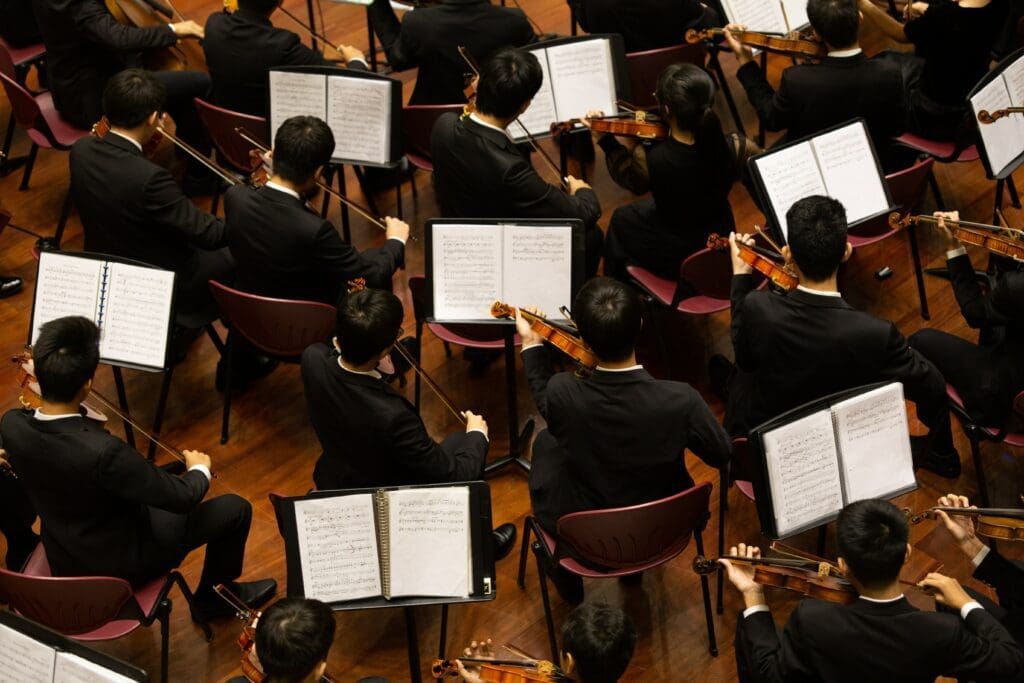
Whether you’re looking for easy sheet music or something more complex to sharpen your skills, there are plenty of resources to help you find free sheet music. With the convenience of digital files, the quickest and easiest method of getting free sheet music is through online services, such as sheetmusic-free.com, Musicnotes, and Musescore. Additionally, forums and online communities, such as r/sheetmusic, are a great way to find and share interesting sheet music.
Sheet Music for Instruments
Sheet music can differ according to the needs of different instruments, such as including grand staffs for instruments with more extensive ranges. However, the fundamentals of sheet music typically stay the same. So, from easy flute sheet music to intricate piano solos, here are links to help you find free instrument-specific sheet music:
- Piano sheet music
- Clarinet sheet music
- Flute sheet music
- Guitar sheet music
- Trumpet sheet music
- Drum sheet music
- Flute sheet music
- Violin sheet music
Sheet Music for Popular Songs
Some compositions have stood the test of time and proven themselves to be favourite tunes of musicians throughout the years. From nursery rhymes to classical masterpieces, here’s a selection of timeless songs for you to try your hand at:
Jingle Bells sheet music
Written in 1850 by James Lord Pierpont, Jingle Bells has become a holiday classic. While its origins are somewhat questionable, owing to Pierpont’s support of the Confederacy and his dedicating the song to the organiser of a minstrel troupe, the song is instantly recognisable worldwide and was even one of the first songs performed in space.
The Entertainer sheet music
Scott Joplin’s most famous classic ragtime number was composed in 1902 and is a bouncy and upbeat piano composition. With its syncopated rhythm and frequent use of consecutive right-hand octaves, The Entertainer is a challenging but fun song to play.
Twinkle Twinkle Little Star sheet music
Twinkle, Twinkle, Little Star is a famous English lullaby that features song lyrics from “The Star”, a 19th-century poem by Jane Taylor. It includes a simple but unforgettable melody that is one of the first tunes many musicians will learn when learning to play a new instrument.
Golden Hour sheet music
Golden Hour is a pop song released by singer-songwriter JVKE in 2022. Alongside pop staples such as soaring melodic vocals and a modern trap-inspired beat, Golden Hour also features some beautiful piano work, including a series of fast-paced eighth-note patterns that are great fun to try and learn.
Traditional Music
Amazing Grace sheet music
Amazing Grace, first published in 1779, was written by Anglican clergyman John Newton seven years earlier. Its uplifting message has seen the hymn achieve crossover appeal, influencing everything from gospel music to folk and even pop.
Fur Elise sheet music
One of Ludwig van Beethoven’s most famous compositions, Bagatelle No. 25 in A minor, is more commonly known as “Für Elise”. Beethoven composed the piece in 1810, but it wasn’t published until 1867, forty years after the composer’s death. While it’s not certain who exactly Elise was, the masterpiece has become one of the most famous classical compositions and is a favourite tune for pianists to learn.
Clair de Lune sheet music
Clair de Lune (Moonlight) is the third movement in Claude Debussy’s 1890 composition, Suite Bergamasque and was inspired by Paul Verlaine’s poem of the same name. It’s one of the most famous piano suites of all time and includes some relatively easy passages perfect for beginners looking to expand their skills.
How To Make Sheet Music
Today, many options exist for creating sheet music, including digital solutions and old-fashioned methods. Consider purchasing a manuscript pad if you prefer to put pen to paper. A manuscript pad contains just blank sheet music paper, with empty staves ready for you to notate.
If you want to utilise modern technology, a digital sheet music maker could be just what you’re looking for. With software such as the free MuseScore, you can generate blank sheet music pages ready to notate. MuseScore also supports input via MIDI keyboard, so you can simplify the notating process by just playing your composition.
Closing Thoughts
While it’s no longer relied on to the same extent as it historically has been, sheet music remains an integral part of music. Whether you are a musician learning a piece of music, a composer sharing your ideas, or a conductor trying to communicate to an orchestra, sheet music is a valuable tool for quickly sharing and clarifying information. And with the increasing availability of digital sheet music, there’s never been a better time to take the plunge and start learning how to read sheet music.








